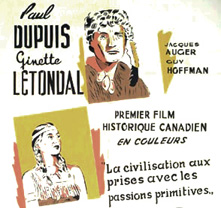Colour
-

Le Petit journal, 24 March 1935, p.17
Source : Bibliothèque et Archives nationale du Québec
-

Poster for the film Étienne Brûlé gibier de potence (Melburn E. Turner, 1952).
Source : Cinémathèque québécoise, 1988.1375.AF
In the early days, people tried to add colour to cinema’s black-and-white images by tinting or colouring the film stock. Then, beginning in the 1910s, experiments were carried out in embedding so-called “natural” colours into the film stock. The use of colour did not become widespread until the marketing of multi-layer film stock (blue-green-red or yellow-magenta-cyan), which made it possible to recreate colour by superimposing three images on the film. The various colour process, with the exception of reversible film stock, all use a negative-positive technique. Reversible film—the most famous of which is Kodachrome—is used mostly in 16mm amateur or non-professional cinema. This explains why a good many films shot in Quebec in 16mm are in colour. The same is true of films made at the National Film Board. The first, and before the arrival of television only film made in colour in Quebec, Étienne Brûlé, gibier de potence (Melburn Turner, 1952), was shot on reversible 16mm film stock and blown up to 35mm for commercial release.
- Themes
- 16 mm
- Native Peoples in the Cinema
- The Talkies Arrive
- Television
- French Canadians at the NFB
- Censorship
- Religious Cinema
- Settling the Land
- Film and French language
- Cinema and Religion
- 16mm Exhibition Circuits
- Quebec’s French Cousins in its Cinema
- Colour
- Film Distributors and Exhibitors
- Hollywood in Quebec
- Maria Chapdelaine
- Quebecers in Hollywood
- Radio and Cinema
- The Massey Report
- Film Magazines
- Second World War
- Organisations
- Biographies
- Juliette Béliveau
- Jean-Yves Bigras
- Léo Choquette
- Fifi D'Orsay
- René Delacroix
- J.A. DeSève
- George Ganetakos
- Pauline Garon
- Gratien Gélinas
- Nicole Germain
- John Grierson
- Paul Gury
- Richard Jarvis
- Paul L'Anglais
- Louis-Roger Lafleur
- Herménégilde Lavoie
- Ovila Légaré
- Guy Mauffette
- Joseph Morin
- Fedor Ozep
- Jean Palardy
- Vincent Paquette
- Jean-Marie Poitevin
- Maurice Proulx
- Roger Racine
- Norma Shearer
- Gordon Sparling
- Albert Tessier
To learn more
- Coup d’œil au studio. Dir. : Henri Michaud [Renaissance Films Productions, 1949]
- La dame aux camélias, la vraie. Dir. : Gratien Gélinas [1942]
- Parade de barques. [Service de ciné-photographie, 1947]
- Sainte-Anne-de-Roquemaure : un épilogue à En pays neufs. Dir. : Maurice Proulx [1942]
- Ski in the Valley of the Saints. [National Film Board of canada, 1944]
- [Trans Canada Summer (1)]. [stockshot, National Film Board of Canada, 1952]
- [Trans Canada Summer (2)]. [stockshot, National Film Board of Canada, 1952]
- [Trans Canada Summer (3)]. [stockshot, National Film Board of Canada, 1952]